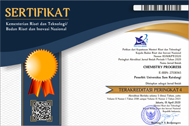POTENSI ANTIOKSIDAN EKSTRAK DARI KULIT BIJI MATOA (Pometia pinnata J. R & G. Forst)
DOI:
https://doi.org/10.35799/cp.15.1.2022.43151Keywords:
Ekstrak kulit biji matoa, skrining fitokimia, antioksidanAbstract
Buah matoa (Pometia pinnata J. R & G. Forst) merupakan tanaman yang tumbuh di wilayah Indonesia. Menurut beberapa penelitian tanaman matoa diketahui memiliki senyawa golongan alkaloid, saponin, tannin, triterpenoid, flavonoid, fenolik dan vitamin A, C, E yang dapat meningkatkan sistem kekebalan tubuh. Buah Matoa juga memiliki aktivitas antibakteri dan antioksidan, yang dapat digunakan sebagai komponen senyawa bioaktif. Bagian biji matoa belum dimanfaatkan secara optimal. Sehingga, penelitian ini bertujuan untuk mengetahui senyawa fitokimia dan antioksidan dari kulit biji matoa. Penelitian ini dilakukan menggunakan metode skrining fitokimia untuk mengetahui senyawa yang terkandung dalam kulit biji matoa. Penentuan akitivitas penangkal radikal bebas dengan menggunakan metedo DPPH dan ABTS. Hasil penelitian menunjukkan bahwa ekstrak kulit biji matoa mengandung senyawa flavonoid, saponin dan tannin. Hasil pengujian aktivitas antioksidan dengan metode DPPH menunjukan ekstrak kulit biji matoa EMK (90,26%), diikuti EEAK (90,05%), dan NHK (7,40%). dan hasil pengujian aktivitas antioksidan dengan metode ABTS menunjukan ekstrak kulit biji matoa EEAK (88,47%), diikuti EMK (93,91%), dan EHK (88,84%).
ABSTRACT
Â
Matoa fruit (Pometia pinnata J. R & G. Forst) is a plant that grows in the territory of Indonesia. According to several studies, the matoa plant is known to have alkaloids, saponins, tannins, triterpenoids, flavonoids, phenolic compounds and vitamins A, C, E which can boost the immune system. Matoa fruit also has antibacterial and antioxidant activity, which can be used as a component of bioactive compounds. The seeds of matoa have not been used optimally. Thus, this study aims to determine the phytochemical and antioxidant compounds from the matoa seed coat. This research was conducted using a phytochemical screening method to determine the compounds contained in the matoa seed coat. Determine the free radical scavenging activity using the DPPH and ABTS methods. The results showed that the matoa seed coat extract contained flavonoid compounds, saponins and tannins. The results of the antioxidant activity test using the DPPH method showed that the matoa seed coat extract was EMK (90.26%), followed by EEAK (90.05%), and NHK (7.40%). and the results of the antioxidant activity test using the ABTS method showed that the matoa seed coat extract was EEAK (88,47%), followed by EMK (93,91%), and EHK (88,84%).












